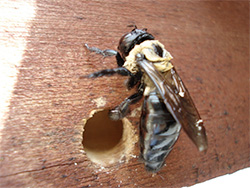ManageSafe
Least-Toxic Control of Carpenter Bees Choose a different pests

|
Factsheet: Least-toxic Control of Carpenter Bees
Identification
Pest type: Insects
In-depth Information:
Carpenter bees are most often confused with bumblebees. They are large, about 1 inch (25 mm) long and have a noticeably hairy thorax and legs, but a hairless abdomen. The abdomen is metallic or iridescent, and may reflect blue, blue-black, bronze, purple, green or buff, depending upon the species.
Carpenter bees have distinct preferences for certain species of softwoods, and do not attack wood that is soft due to decay or tunnel in wood with bark still on it. Their favorites include southern yellow pine, white pine, California redwood, cedar, Douglas fir, and cypress. They chew with their mouthparts into structures, most frequently attacking roof trim and siding, exterior columns, steps, decks, and porch beams and railings. Their entrance is usually against the grain, except where it starts on the end of a board. Approximately 1 inch into the wood, the tunnel turns abruptly at a right angle, and, in newly excavated areas, travels with the grain from 4-6 inches. Several bees working together over a period of time can form a system of galleries extending as far as 6-9 feet into the timber.
Is it a problem?
The threshold (the number of carpenter bees necessary to generate concern and action) for carpenter bees depends on the wood that is being damaged. If the bees are chewing on a piece of wood with little value, the threshold would be higher than if the damage was being done to a historic home.
Carpenter bees should be protected whenever possible; they are valuable pollinators and do not pose a threat to humans. They tunnel very slowly and their damage is very easily curbed.
They fly and hover with little regard to human activity. Males cannot sting and pose no threat to humans, though their interactions are noisy and may seem threatening as they defend and challenge each other over their territories. Females concentrate on provisioning their nests and are most often seen entering and emerging from large entrance holes in wood or in flowers searching for pollen. They can sting, but won’t, although they may bite if handled roughly.
Pest prevention practices
Foster natural resilience
In-depth Information:
Do not build external structures with unpainted and unvarnished wood that carpenter bees find attractive. Roof trim, siding, exterior columns, steps, decks, porch beams, and railings are all possible nesting grounds. Keep exposed wood in vulnerable areas covered with paint or varnish, or metal or fiberglass materials.
Fill depressions in wood, which will attract female carpenter bees, before painting. Repaint as often as necessary to keep up with weathering, paying particular attention to undersides of siding and trim.
Woodpeckers and other birds are common predators of young carpenter bees, so make efforts to promote beneficial birds in the area.
Monitoring and record-keeping
- Look for inch-diameter holes on structures. Sometimes there will be sawdust beneath. Woodpeckers are attracted to carpenter bee nests. Damage on the structure from this bird may indicate a nest.
Non-chemical and mechanical controls
Repair holes
Remove debris and habitat
In-depth Information:
When a nest is detected, seal it off or replace the damaged wood. After the bees have emerged, plug holes in wood with steel wool and staple on metal screen. Soft material such as wood putty or caulk will not prevent bee re-entry. You can also use aluminum, asphalt or fiberglass materials. The best time to physically renovate the structure is in the spring after the bees have left their nest.
Biological controls
Attract woodpeckers and other birds, which often feed on carpenter bees, to your landscape.
Least-toxic chemical options as a last resort
- Repellants offer a temporary solution until physical alterations can be made. Almond oil and almond essence placed around the nest will repel the carpenter bees. Borates have been shown to be effective in discouraging wood infesting insects. The borate material can be applied to wood as it is used in new construction or on wood that is being used in repairs.
- Borate treated wood remains coated longer if it is not in direct line with rain and water.
- Silica gel can also be applied to the nesting tunnel (hole), after the female has left the nest, and will kill the larva as it attempts to emerge the following Spring. After applying the silica gel, the nesting hole should be closed up from the elements to protect the gel from the environment.
Chemicals to Avoid
Look at your product labels and try to avoid products containing those chemicals listed below:
(A = acute health effects, C = chronic health effects, SW = surface water contaminant, GW = ground water contaminant, W = wildlife poison, B = bee poison, LT = long-range transport)
|
Bifenthrin Carbaryl Chlorpyrifos | Cyfluthrin Cypermethrin Deltamethrin | Lambda-cyhalothrin Permethrin Pyrethrins | Resmethrin |
Social Media
See what other folks are saying about this, and let us know what works for you.
Hi Everyone! It’s Friday, which means that it is time for Question of the Week! We have been getting calls lately about...
Posted by Beyond Pesticides on Friday, June 26, 2015
Click the post above to view and comment on Facebook, or comment directly on this site below.








